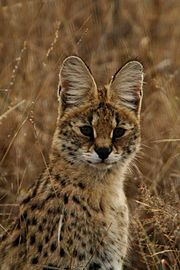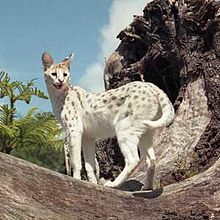Serval
| Serval[1] | |
|---|---|

| |
| Scientific classification | |
| Kingdom: | |
| Phylum: | |
| Class: | |
| Order: | |
| Family: | |
| Genus: | Leptailurus Severtzov, 1858
|
| Species: | L. serval
|
| Binomial name | |
| Leptailurus serval | |

| |
| Serval range | |
The Serval (Template:Pron-en), Leptailurus serval, is a medium-sized African wild cat. Molecular DNA analysis indicates Servals descended from the same ancient Felid ancestor as the Lion, but the Serval maintains its own unique lineage and does not branch from any other cat species, although they appear to share common traits with the Cheetah. However, similar studies has shown the serval to be closely related to the African Golden Cat and the Caracal.[3]. The length is 85-112 cm (33-44 in), plus 30-50 cm (12-20 in) of tail, and the shoulder height is about 54-66 cm (21-26 in). Weight ranges from 9 to 16 kg (20-35 lbs) in females, and from 12 to 26 kg (26-57 lbs) in males. Life expectancy is about 12–16 years in the wild, and up to 20–25 years in captivity. It is a strong yet slender animal, with long legs and a fairly short tail. The head is small in relation to the body, and the tall, oval ears are set close together. The pattern of the fur is variable. Usually, the Serval is boldly spotted black on tawny, with 2 or 4 stripes from the top of the head down the neck and back, transitioning into spots. The "servaline" form has much smaller, freckled spots. In addition, melanism is known to exist in this species, giving a similar appearance to the black panther. White servals are white with silvery grey spots and have only occurred in captivity.
Its main habitat is the savanna, although melanistic individuals are more usually found in mountainous areas. The Serval needs watercourses within its territory, so it does not live in semi-deserts or dry steppes. It is able to climb and swim, but seldom does so. It has now dwindled in numbers due to human population taking over its habitat and also hunting its pelt. It is protected in most countries. The Serval is listed in CITES Appendix 2, indicating that it is "not necessarily now threatened with extinction but that may become so unless trade is closely controlled."[4]
Subspecies
- Leptailurus serval serval, Cape Province
- Leptailurus serval beirae, Mozambique
- Leptailurus serval brachyurus, West Africa, Sahel and Ethiopia
- Leptailurus serval constantinus, Algeria (endangered)
- Leptailurus serval faradjius
- Leptailurus serval ferrarii
- Leptailurus serval hamiltoni, eastern Transvaal
- Leptailurus serval hindei, Tanzania
- Leptailurus serval kempi, Uganda
- Leptailurus serval kivuensis, Congo
- Leptailurus serval lipostictus, northern Angola
- Leptailurus serval lonnbergi, southern Angola
- Leptailurus serval mababiensis, northern Botswana
- Leptailurus serval pantastictus
- Leptailurus serval phillipsi
- Leptailurus serval pococki
- Leptailurus serval robertsi, western Transvaal
- Leptailurus serval togoensis, Togo and Benin
Hunting and Diet

Although the Serval is specialized for catching rodents, it is an opportunistic predator whose diet also includes birds, hares, hyraxes, reptiles, insects, fish, and frogs.[5] The Serval has been observed taking larger animals, such as deer, gazelle, and springbok, but over 90% of the Serval's prey weighs less than 200g (7 oz).[6] The Serval eats very quickly, and if its food is big enough, it sometimes eats too quickly, causing it to regurgitate the food due to clogging in the throat. Small prey are devoured whole. With larger prey, small bones are consumed, but organs and intestines are avoided along with fur, feathers, beaks, feet or hooves. The Serval utilizes an effective plucking technique in which they repeatedly toss captured birds in the air while simultaneously thrashing their head side-to-side, removing mouthfuls of feathers, which they discard.
As part of its adaptations for hunting in the savannas, the Serval boasts long legs (the longest of all cats, relative to body size) for jumping, which also help it achieve a top speed of 50 mph, and large ears with acute hearing. The long legs and neck allow the Serval to see over tall grasses, while its ears are used to detect prey, even those burrowing underground. The Serval has been known to dig into burrows in search of underground prey, and to leap 8-16 feet in the air to grab birds in flight. While hunting, the Serval may pause for up to 15 minutes at a time to listen with eyes closed. The Serval's pounce is a distinctive and precise vertical 'hop', which may be an adaptation for capturing flushed birds.[7] The Serval is an efficient killer, catching prey on an average of 50% of attempts (with a 67% success rate at night), compared to around one in ten attempts for most species of cat.[6]
Servals are extremely intelligent, and demonstrate remarkable problem-solving ability, making them notorious for getting into mischief, as well as easily outwitting their prey, and eluding other predators. The Serval will often play with its captured prey for several minutes, before consuming it. In most situations, Servals will ferociously defend their food against attempted theft by others. Males can be more aggressive than females.
The Serval is reputed to be the most effective hunter of all mammals in the animal kingdom.
Breeding
The gestation period for a female Serval is 66–77 days - 2 to 2 1/2 months. The litter consists of two or three young (called kittens), sometimes as few as one or as many as five. They are raised in sheltered locations such as abandoned aardvark burrows. If such an ideal location is not available, a place behind a shrub may be sufficient. The Serval is sometimes preyed upon by the Leopard and other large cats. More dangerous for this cat are humans. The Serval was extensively hunted for its fur. It is still common in West and East Africa, but it is extinct in the South African Cape Province and very rare north of the Sahara.

Color phases
Melanistic Servals have been reported both in wild populations and in captivity. White Servals have never been documented in the wild and only four have been documented in captivity. One was born and died at the age of 2 weeks in Canada in the early 1990s. The other three, all males, Kongo (deceased) Tongo and Pharaoh were born at Wildlife on Easy Street in 1997 and 1999.[citation needed]

Domestication
As with the Cheetah, most Servals are friendly, good-natured, and easily tamed. Ancient Egyptians worshipped the Serval as gods. Servals are often kept as loving pets, and they develop an intense emotional bond to their original owners. They do not easily accept new owners or surroundings, and may become unhappy and fierce if separated. Servals have been bred with the domestic cat to create a hybrid breed of domestic cat called the Savannah.
Vocalizations
Servals belong to the purring cats. A characteristic of purring is that it is carried out on both egressive and ingressive airstream. A purring serval can be heard on Robert Eklund's Ingressive Speech website [1] or on Robert Eklund's Wildlife page [2]. The Serval also has a high-pitched chirp, a hiss, cackle, growl, grunt, and meow.
Heraldry and literature
The Serval Template:In it was the symbol of the Tomasi family, princes of Lampedusa, whose best-known member was Giuseppe Tomasi di Lampedusa, author of one of the most famous Italian novels of the 20th century, Il Gattopardo.
-
A serval viewed from behind. Note the white markings used to signal kittens when hunting.
-
A male serval in the Sabi Sands, South Africa.
References
- ^ Wozencraft, W. C. (2005). "Order Carnivora". In Wilson, D. E.; Reeder, D. M. (eds.). Mammal Species of the World: A Taxonomic and Geographic Reference (3rd ed.). Johns Hopkins University Press. p. 540. ISBN 978-0-8018-8221-0. OCLC 62265494.
- ^ Template:IUCN2008 Database entry includes justification for why this species is of least concern
- ^ Johnson; et al. The Late Miocene Radioton of Modern Felidae: A Genetic Assessment. pp. 73–77, Science Vol. 311.
{{cite book}}: Explicit use of et al. in:|author=(help) - ^ CITES Appendices
- ^ "Serval". African Wildlife Foundation. Retrieved 2007-03-13.
- ^ a b "The Serval". Cat Survival Trust. Retrieved 2007-03-13.
- ^ Hunter, Luke, Hinde, Gerald. Cats of Africa. New Holland Publishers. pp. 61–62.
{{cite book}}: CS1 maint: multiple names: authors list (link)
External links
- serval-cats.com - pictures, breeders, some information
- world conservation union site - detailed information
- cat survival trust - basic information, some graphics
- big cats online - short write-up
- Sierra Safari Zoo - some general information, zoo-specific details
- servals.org - servals in the wild and as pets
- ExoticCatz.com - Servals as Pets - care and feeding, many articles and photos
- IUCN Red List least concern species
- Felines
- Fauna of Algeria
- Fauna of Angola
- Fauna of Botswana
- Fauna of Burkina Faso
- Fauna of the Democratic Republic of the Congo
- Fauna of East Africa
- Mammals of Kenya
- Fauna of Morocco
- Fauna of Namibia
- Fauna of the Sahara
- Fauna of South Africa
- Fauna of Tanzania
- Fauna of West Africa
- Fauna of Zambia
- Mammals of Africa
- Pet mammals



